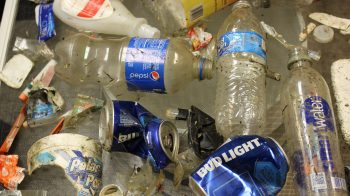Bob Moon: This morning, I used a plastic toothbrush, a plastic hairbrush, and I grabbed a plastic water bottle, and I just used a plastic pen to edit this story. As a rule, most of us have come to think of plastic as bad — something that does lasting damage to the environment. But it’s more complicated than that.
Susan Freinkel writes about our relationship with plastic in her new book, “Plastic: A Toxic Love Story.” Welcome to the program.
Susan Freinkel: Thank you.
Moon: Let’s start with a little history first. Plastic — evil to the environment as we know it today — but it was actually created to help preserve natural resources and animals, like the elephants, wasn’t it?
Freinkel: Yeah, that’s right. In fact, one of the first early plastics — celluloid — was developed in response to an ad by a billiard ball maker because billiard balls were made out of ivory and there were widespread fears in the mid-19th century that so many elephants were being hunted that they soon wouldn’t have any ivory that they needed for the balls. So they offered $10,000 in gold for anyone who could come up with a good substitute. And John Wesley Hyatt answered the ad and developed this fantastic substitute, celluloid. Which as it turned out, wasn’t so great for billiard balls, but it turned out to be great for lots of other things — from combs and buttons to Kewpie dolls and more.
Moon: Fast forward to today, how dependent on plastic are we? I mean, as I pointed out earlier, I use plastic things more often than I don’t.
Freinkel: Yeah, that’s right. We are completely surrounded by plastic, and our consumption and use of it has just continued to rise, particularly in the last 50 years. So that in 1960 the average American consumed about 30 pounds of plastic. Now it’s 300 pounds a year.
Moon: Now you trace plastics’ history through different products — the comb, the frisbee, the IV bag. Why that in particular?
Freinkel: Well I use the IV bag to talk about plastic in medicine. In medicine, plastic is kind of a double-edged sword. The invention of a plastic blood bag was huge in revolutionary impact in medicine. It really changed the way blood banking worked and made it much more feasible than it had been in the past. But the material that it’s made out of, vinyl, leaches chemicals that are hormone disruptors. They interfere with testosterone and can affect the way that bodies develop, particularly if infants are exposed.
Moon: Now that’s a pretty common thread through. It does have its important uses, but there is also a down side to plastic and the harm it can cause.
Freinkel: Plastic is great stuff. I do not demonize plastic and I don’t think we ought to. The problem is that we’ve used it all too often in foolish and short-sighted ways.
Moon: Yeah, here’s a quote from you that I think says it all: “We take natural substances created over millions of years, fashion them into products designed for a few minutes’ use, and then return them to the planet as litter that we’ve engineered to never go away.
Freinkel: Yeah, that’s right. And isn’t that crazy? About half of all plastics go into disposable items. And again, some of those disposables are great things. I mean, boy, you wouldn’t want to be in Japan right now and not be able to get your water from a plastic water bottle. But does that mean that all of us need to be carrying around water bottles and buying our beverages in throwaways plastic bottles every day.
Moon: So what’s the balance? How do you modify our relationship with plastic to make it less bad for us?
Freinkel: Well I think one place we start is by recognizing, again, that these are valuable materials and really thinking hard about where it makes sense to use them. Disposable items — that’s a great invention, it’s brought modern convenience — but again, sometimes that convenience comes with a huge cost and I think we need to be asking ourselves when it that cost really worth it? When could we go back to using something that is more reusable.
Moon: Susan Freinkel’s new book is called “Plastic: A Toxic Love Story.” Thanks for joining us.
Freinkel: Thank you so much for having me.
There’s a lot happening in the world. Through it all, Marketplace is here for you.
You rely on Marketplace to break down the world’s events and tell you how it affects you in a fact-based, approachable way. We rely on your financial support to keep making that possible.
Your donation today powers the independent journalism that you rely on. For just $5/month, you can help sustain Marketplace so we can keep reporting on the things that matter to you.


















